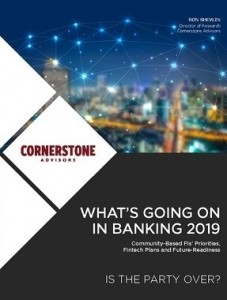Getting a handle on what’s happening in banking this year and in the future is a big challenge.

Cornerstone Advisors surveyed 305 senior executives at US-based, mid-size financial institutions (FIs), 60% from banks and 40% from credit unions to get a picture of banking in 2019. The result is an interesting look at the quickly changing financial services marketplace and its challenges.
Optimism remains positive
Overall, the majority of executives surveyed were very optimistic (10%) or somewhat optimistic (41%) about the industry in the year ahead. Only 15% were somewhat pessimistic and none were very pessimistic. 34% remained unchanged from last year.
Top banking industry concerns

In this year’s survey, Cornerstone added “growing deposits” to the list of concerns. Half of the bank executives surveyed (50%) cited “growing deposits” as their biggest concern followed by the interest rate environment (41%), cybersecurity (34%), cost of funds (29%), weak economy/loan demand (25%), new customer/membership growth (24%), and the regulatory burden (21%).
The weak economy/gloom demand was the only category that showed a slight increase from 21% in 2018 to 24% this year.
Credit union executives highlighted similar concerns about growing deposits (54%), the interest rate environment (37%), cybersecurity (34%), cost of funds (33%), weak economy/loan demand (24%), new customer/membership growth (24%), and the regulatory burden (21%).
Cornerstone characterized the concerns as “paycheck motels”:
“Banks and credit unions are feeling the impact of deposit displacement—the diversion, or displacement, of funds from traditional checking accounts to alternative accounts—as consumers put their money into health savings accounts, P2P payments tools like Venmo and Square Cash, savings tools like Acorns and Stash, and robo-advisor tools like Betterment. Bottom line: Checking accounts have become paycheck motels—temporary places for people’s money to stay before it moves on to bigger and better places— making the goal of growing deposits more difficult than it was in the past.”
Top business priorities

When it comes to business priorities, banks and credit unions shared mostly similar view. Growing commercial loans (60%) was a top priority, followed by grow commercial deposits (56%), grow consumer deposits (46%), expand digital and mobile presence (37%), improve market share among small business (18%), improve sales and marketing (16%), grow mortgage loans (15%), grow wealth management business (14%), and find good merger/acquisition partners (10%).
The report highlighted three big differences for banks from 2018 including a drop in the focus on improving sales and marketing; an increase from 9% to 18% in small business growth; and an increase from 7% to 15% in growing mortgage loans.
Credit unions naturally reflected some differences in focus as consumer growth (64%) was the top priority followed by an expanded digital presence (49%), grow consumer loans (40%), improve sales and marketing (28%), grow commercial/business loans (24%), grow mortgage loans (20%), and grow commercial deposits (16%).
According to Cornerstone Advisors Managing Director Jim Burson:
“Deposit strategies must go beyond price. FIs should create offers that combine mobile information and security with underlying money movement capabilities. In addition, sales and marketing capabilities are an essential part of having a digital presence. Without both, it’s like using a toothbrush without toothpaste – it works, but it’s not very effective.”
Lending priorities

Already a top lending priority, even more banks will focus on commercial C&I loans in 2019 than they did in 2018. Small business loans were cited as a high priority for 2019 by nearly seven in 10 banks—up from 56% in 2018.
For credit unions, “high” lending priorities include consumer loans (77%), auto loans (61%), home equity loans (60%), consumer personal loans (44%), commercial real estate loans (34%), and small business loans (28%).
Payments priorities

The importance of treasury/cash management services makes a big jump in 2019, as the percentage of banks considering it a “high” priority increased from 52% to 72%. According to Cornerstone Advisors’ Burson: “Hand in hand with the need for deposits is the need to improve treasury offerings, which will put downward pressure on fee income tied to these services as competition heats up in the quest for liquidity.”
Other “high” payments priorities for banks included a focus on debit cards (62%), mobile bill payments (32%), mobile payment tools (30%), credit cards (29%), and mobile wallets (27%).
“High” payments priorities for credit unions show a somewhat different profile with a focus on credit cards (74%), debit cards (71%), mobile bill payments (28%), mobile payment tools (20%), and mobile wallets (17%).
The report says banks want consumer deposits—but not consumer loans: “Many banks are missing the potential connection here. Growing consumer relationships through lending products that bring deposits with them—through bundling or pricing incentives—is a successful strategy in a number of banks.”
Fintech path differences between banks and credit unions

Six in 10 credit union and half of bank executives said fintech partnerships, collaborations and/or investments will be very or somewhat important to them in 2019.
Banks and credit unions are focusing their fintech efforts at digital account opening, payments, and lending/credit with one big difference. One-third of banks said new banking products were a priority in contrast to just 20% of credit unions.
Cornerstone further added: “Half of banks and credit unions say fintech partnerships will be important in 2019. Digital account opening, payments and lending top the list of fintech-related priorities. We wonder where these institutions will get the skills to vet and negotiate with potential partners.”
Future readiness?

The banks’ perspective on their future readiness was summarized nicely: “For the third straight year, we asked bank and credit union executives to rate the future-readiness of their organizations. Among bank executives, the information technology function was rated somewhat or very future-ready by nearly two-thirds of respondents. Commercial lending and treasury/cash management both saw significant increases in future-ready assessments from last year’s survey. Marketing was also rated as significantly more future-ready than last year—why we have no idea.”
In contrast, credit unions rated digital banking as their most future-ready function, a big jump in 2019 after a big decline in 2018. IT, fraud/risk management, and the contact center also saw increases in future-readiness assessment, according to Cornerstone.
“The past year (2018) must have been a productive one as future-ready ratings from both bank and credit union execs improved in most categories. Considering the slow uptake of emerging technologies (see the next section), we can’t help but think many executives are deceiving themselves,” the report added.
Slow to adopt emerging technology

Cornerstone said emerging technology is still slow to be adopted and in some cases is not even on the radar for banks.
“Credit unions, on the other hand, appear to be poised to start experimenting with a range of emerging technologies. Nearly three in 10 plan to invest in video collaboration technology, with nearly one in five looking to invest in AI or machine learning. In addition, 10% of credit union execs said they’re planning to invest in blockchain in 20 Credit unions, on the other hand, appear to be poised to start experimenting with a range of emerging technologies. Nearly three in 10 plan to invest in video collaboration technology, with nearly one in five looking to invest in AI or machine learning. In addition, 10% of credit union execs said they’re planning to invest in blockchain in 2019,” the report stated.
Eighty-seven percent of financial institutions will increase tech spending in 2019 from 2018 levels, and in about one-fourth of them, spending will rise by more than 10%.
Cornerstone said that most of the emerging technology initiatives seem very much at the discussion stage at the board level with many organizations, not really understanding what they have, nor what they need when it comes to artificial intelligence, automation, machine learning, and other emerging technologies.

“While the threat of fintech disruptors has morphed into the promise of fintech partnerships, let’s be realistic: Few mid-size FIs have the resources and skills to enter into more than one or two partnerships, and even those partnerships aren’t likely to produce significant benefits in 2019,” said report author Ron Shevlin, Director of Research at Cornerstone Advisors.
All in all, the What’s Going on in Banking 2019 report from Cornerstone Advisors makes interesting reading and you can get a free copy here.

